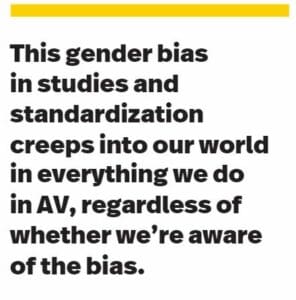“The reasonable man adapts himself to the world; the unreasonable one persists in trying to adapt the world to himself. Therefore, all progress depends on the unreasonable man.” — George Bernard Shaw
People ask me all the time why I volunteer so much. I sit on every committee, panel and council that I can get my hands on. I never say no to a discussion or podcast invitation. I volunteer to write test questions and certification standards for the industry. I teach classes, lead tours and mentor whenever I can. Hell, I’m even the president of my kids’ parent–teacher organization (PTO) at school. “No” might be a complete sentence, but I’ve yet to figure out how to use it as one.
The reason, however, is simple: I want to change the world.
Design For and By Men
Every day, most of us get up, use the bathroom, brush our teeth, make breakfast on a stove, watch the news, get in a car, buckle our seatbelt, open the front door to our office, sit at a conference table with an AV system, listen to music and go to bed. And we do all those things that were designed almost entirely for and by men.
The design flaws can vary from the mildly annoying to the downright unsafe. Have you ever wondered why almost all public spaces — and especially office spaces — have their air conditioning set at a level that makes me want a Snuggie? Here’s the answer: That standard was based on a study of the average metabolic rate of a man who weighs about 175lb. And it was set in the 1960s. Sure, I cuss a little under my breath every time I forget to pack a sweater…in July…in the south. But that doesn’t come close to things like medical studies being performed almost entirely on men, or the fact that even things like seatbelts were built for men, and, thus, women are 47% more likely to be killed in an automobile accident than men are.
This bias in studies and standardization creeps into our world in everything we do in AV, regardless of whether we’re aware of the bias. Recently, I was given the opportunity to teach a class on how to design audio systems for high intelligibility. This is my bread and butter. I went to college for audio design for theater. I can tell you the optimal frequency range for vocals and instruments; I can recite the decibel scales for optimal listening from the start; and I often regale partygoers with the science behind psychoacoustic phenomena. (I’m a real hoot.)
Further Down the Rabbit Hole
But in the course of researching for that audio systems class, I started to go further down the rabbit hole. And what I found was disconcerting. Almost every rule that we follow when it comes to audio systems is in place based on science that only took into account studies with a distinctly male bias.
 That revelation really started to make me look at everything that I interact with. We design AV systems with displays at a certain height…with tunings done to specific frequencies…with touchpanels that were designed for people that are, on average, four inches taller than us. And we do it all on computers that were designed for larger hands than ours are.
That revelation really started to make me look at everything that I interact with. We design AV systems with displays at a certain height…with tunings done to specific frequencies…with touchpanels that were designed for people that are, on average, four inches taller than us. And we do it all on computers that were designed for larger hands than ours are.
I was once designing an executive boardroom for a large corporate headquarters with its sister in Japan. The displays were quite large, putting the bottom of them at about 36 inches off the floor. I immediately changed the initial sketches to put the cameras above the displays and submitted all documentation this way. I was shocked when I came in to commission and saw that the cameras had been moved beneath the displays but that the displays had not been moved up. I asked the concerned parties why this change had been made, and I was informed that, in Japanese culture, it’s considered improper to look down on someone’s head. So, putting the cameras so high was rude. That’s an important lesson I am happy to know.
However, I immediately looked around at the nine men in the room and asked a pointed question: What would happen when a woman — possibly wearing a skirt — sat down at this table? I was answered with crickets. No one had even considered this. The room eventually was completely redesigned, but the lesson remained: Men are the standard. They are the status quo. And, often, we don’t even realize it.
Making the World Fit Women
It’s an unfortunate fact that, if women want this world to fit us, it’s on us to make it happen. No one is going to do it for us.
So, the next time you sit down at a conference table and have to adjust your chair, remember that that table and chair are based in Le Corbusier’s Modulor scale, which used a six-foot-tall Caucasian man for all design.
It’s no longer enough for us to ask for a seat at the table; it’s time to burn the table down and think about why we built it that way in the first place.
Rebecca Sullins’ history and passion lies in audio system design for large-scale performance spaces, and she loves to educate the future of the AV industry.







 Emergency Communications Webinar
Emergency Communications Webinar Shure Stomps Counterfeiting Network
Shure Stomps Counterfeiting Network IPMX
IPMX 
 5K600
5K600














